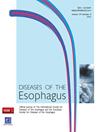250. 一项北美单中心回顾性研究表明,悬索纤维保存诗与诗后gerd症状之间存在关联
IF 2.3
3区 医学
Q3 GASTROENTEROLOGY & HEPATOLOGY
引用次数: 0
摘要
经口内窥镜肌切开术(POEM)是贲门失弛缓症的标准治疗方法。POEM术后胃食管反流病(GERD)一直是该手术的限制因素。据报道,在日本,在POEM期间保留吊索纤维可以减少POEM后胃食管反流,但在西方人群中没有这项技术的报道。因此,我们在我们的机构(加拿大一家大型治疗性内窥镜转诊中心)调查了POEM期间吊索纤维保存与POEM后胃食管反流症状的关系。这是一项回顾性的单中心研究,研究对象是2017年10月至2023年1月在我们中心接受POEM治疗的患者。第一组患者在2021年6月之前接受常规POEM治疗,之后随着技术的进步,第二组患者接受了带有吊索纤维保存的POEM治疗。主要终点是POEM术后GERD阳性症状的发生率。次要结果为手术时间、切肌时间、临床成功率(Eckard评分小于3分)、不良事件发生率和随访时PPI的使用。本研究纳入148例POEM(52.5±15.6 y/o,女性61例(43%))。两组患者特征无显著差异。传统组和改良组的平均手术时间(108.6±34.5 vs 109.1±45.7 min, P = 0.93)和不良事件发生率(21% vs 14%, P = 0.36)相似。在悬吊纤维保存组,胃肌切开术长度明显更长(2.2±0.7 vs 1.6±0.8 cm, P < 0.05),但随访时胃食管反流症状率明显较低(22% vs 41%, P < 0.05),尽管PPI使用相似(57% vs 50%, P = 0.47)。最后,两组临床成功率相似(88% vs 84%, P = 0.6)。在POEM期间保留吊带纤维是安全的,并减少POEM后胃反流症状,尽管胃肌切开术长度较长。因此,吊索纤维保存可能是减少西方人群诗后反流的有效解决方案。本文章由计算机程序翻译,如有差异,请以英文原文为准。
250. ASSOCIATION OF SLING-FIBER PRESERVATION POEM AND POST-POEM GERD SYMPTOMS: A NORTH AMERICAN SINGLE-CENTER RETROSPECTIVE STUDY
Peroral endoscopic myotomy (POEM) is standard treatment for achalasia. Gastroesophageal reflux disease (GERD) after POEM has been a limiting factor with this procedure. Preservation of the sling fiber during POEM was reported to reduce post-POEM GERD in Japan, but there are no reports of this technique in a western population. As such, we investigated the association of sling-fiber preservation during POEM and post-POEM GERD symptoms at our institution, which is a large therapeutic endoscopy referral center in Canada.
This is a retrospective, single-center study of patients who underwent POEM from October 2017 to January 2023 at our center. The initial cohort of patients were treated by conventional POEM until June 2021, after which a second cohort underwent POEM with sling-fiber preservation, as the techniques advanced. The primary outcome was the rate of positive GERD symptoms after POEM. The secondary outcomes were procedure time, gastric myotomy length, clinical success rate (Eckard score of less than 3), adverse events rate and use of PPI at follow-up.
148 POEM cases (52.5 ± 15.6 y/o, female: 61(43%)) were included in this study. There was no significant difference in patient characteristics between the groups. The mean procedure time (108.6 ± 34.5 vs 109.1 ± 45.7 min, P = 0.93) and rate of adverse events (21% vs 14%, P = 0.36) were similar between the traditional and modified groups. In the sling fiber preservation group, gastric myotomy length was significantly longer (2.2 ± 0.7 vs 1.6 ± 0.8 cm, P < 0.05) yet the GERD symptom rate at follow-up was significantly lower (22% vs 41%, P < 0.05), although PPI use was similar (57% vs 50%, P = 0.47). Finally, the clinical success rate was similar between groups (88% vs 84%, P = 0.6).
Sling fiber preservation during POEM is safe and reduces post-POEM GERD symptoms, despite the longer gastric myotomy length. As such, sling fiber preservation may be a useful solution to reduce post-POEM GERD in western populations.
求助全文
通过发布文献求助,成功后即可免费获取论文全文。
去求助
来源期刊

Diseases of the Esophagus
医学-胃肠肝病学
CiteScore
5.30
自引率
7.70%
发文量
568
审稿时长
6 months
期刊介绍:
Diseases of the Esophagus covers all aspects of the esophagus - etiology, investigation and diagnosis, and both medical and surgical treatment.
 求助内容:
求助内容: 应助结果提醒方式:
应助结果提醒方式:


